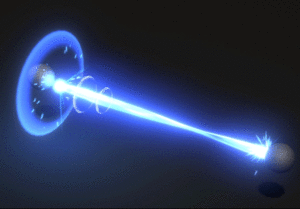
The repair beam is a highly advanced mix of technologies used to repair damaged systems and materials at a highly accelerated rate. It blends a type of molecular quasi-matter with molecular replicators / transporter technologies. The system is designed to project material onto a remote location within a maximum of 2 meters in layers are a molecular scale. In this way it projects material onto a damaged or empty space and binds this matter to existing matter at the target location constructing new material from a molecular level. In this way it is able to effect repairs are an incredibly high rate of speed.
Repair Phase
- . The recycled based-atomic matter stream is resequenced into molecular matter for use by micro-replicators.
- . Micro-replicators operating with molecular resolution which produce microscopic amounts of matter very quickly, on the level of 150 cubic micrometers.
- . Replicated matter is partially dematerialized and phased by a molecular level micro-transporter node generating an equal mass quantity of quasi-matter.
- . Quasi-matter is transmitted along a focused phased plasma beam path to the target surface, where it collects in a phased state between matter an energy.
- . Collected quasi-matter is de-phased and materialized in its original pattern by the molecular level micro-transporter node.
Recycling Phase
- . A micro-transporter node operating in molecular resolution dematerializes unwanted, damaged, or otherwise unusable waste-matter./
- . Recycled matter is stored within a transporter pattern buffer and is molecularly resequenced into base materials at the atomic level.
Power Usage
The repair beam is a very energy-intensive endeavor, relying on being able to recycle existing matter in the form of dematerializing damaged materials. Even with this recycling of waste materials it is a power-intensive process, which does not replace conventional repairs.